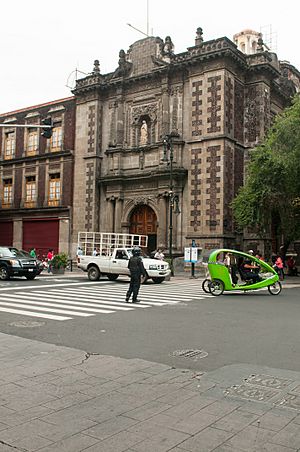Iglesia de San Bernardo, Mexico City facts for kids
Quick facts for kids Church of San Bernardo |
|
|---|---|

Church of San Bernardo in Mexico City
|
|
| Location | Mexico City |
| Country | Mexico |
| Denomination | Roman Catholic |
| Religious institute | Cistercians |
| History | |
| Consecrated | 1690 |
| Architecture | |
| Architect(s) | Juan de Zepeda |
| Style | Baroque |
| Groundbreaking | 1685 |
| Completed | 1687 |
The Church of San Bernardo (also known as Iglesia de San Bernardo in Spanish) is a beautiful old church in Mexico City. You can find it near the main square, called the Zocalo, at the corner of Avenida 20 de Noviembre and Venustiano Carranza Street. It used to be part of a larger building complex, a convent, which was started way back in 1636. However, during a time called La Reforma in 1861, many convents and monasteries were closed down, including this one. Today, only the church building is left from the original convent. The church itself was built between 1685 and 1687. It was designed in the fancy and detailed Baroque style.
History of the Church
The Church of San Bernardo was once part of a convent. A wealthy merchant named Juan Marquez de Orozco helped pay for it. He wanted his money to be used to build a convent for the Cistercian Order, which is a group of nuns.
After Juan Marquez de Orozco passed away, another important person, José Retes de Largacha, Marquis of San Jorge, became the main supporter. He bought the land where the church and convent were built. The convent officially started in 1636. Three of Orozco's sisters and two other nuns, who came from another convent called Regina Coeli, were among the first members.
The church building was finished and officially opened in 1690. Later, in the 1700s, Miguel de Berrio y Saldivar, Count of San Mateo Valparaiso, helped with repair work. During these repairs, a special type of stone called tezontle was used. The church was rededicated in 1777 after these improvements.
The Reform Period
During a time in Mexico's history known as the Reform period, led by Benito Juárez, many religious buildings like monasteries and convents were closed. The San Bernardo convent was torn down, but luckily, the church building was saved. The demolition of the convent made way for a new street, which is now called 20 de Noviembre.
What the Church Looks Like
The outside of the church, called the façade, is mostly covered in a reddish, porous volcanic rock called tezontle. The decorations on the main front of the church show a "discreet" Baroque style. This means that not every part of the surface is covered in decorations, but the areas that are decorated are very detailed and fancy.
The detailed work on this church's exterior has been compared to the fine work done by silversmiths, like filigree. The Baroque style really stands out around the special carved areas called niches. One of these niches holds a statue of Saint Bernard, and another has a figure of the Virgin of Guadalupe. The Virgin of Guadalupe statue used to be on the other side of the convent complex, but it was moved to the church when the convent was taken apart. The main architect who designed the church was Juan de Zepeda.
On the outside wall, there is a bronze plaque. It says, "Las Religiosas Concepcionistas del Convento del Dulcísimo Nombre de María del Glorioso San Bernardo. Fundado el 30 III 1636 in este Lugar, Celebramos 350 años de su fundación, 1986." This plaque celebrates the 350th anniversary of the convent's founding in 1986.
Inside the church, you will find a neo-classic altar.
See also
 In Spanish: Iglesia de San Bernardo (Ciudad de México) para niños
In Spanish: Iglesia de San Bernardo (Ciudad de México) para niños
- List of colonial churches in Mexico City

